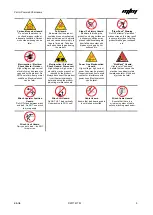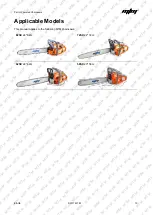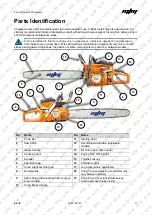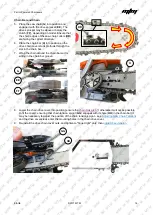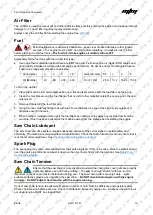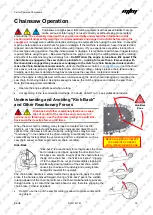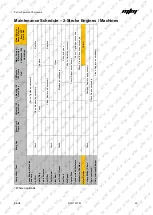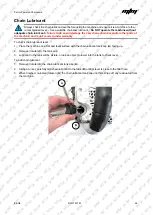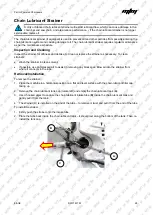
Petrol Powered Chainsaws
E&OE
©2017 MTM
17
Engine Starting and Stopping
Ensure that blade sheath is removed and that the saw chain is not in contact with, or near
any objects before starting the engine. • Once the engine is running at sufficient speed, the
clutch will engage and begin rotating the saw chain. • Do NOT "drop start" the machine as this is extremely
dangerous. •
Do NOT start the engine with the chain bar in a cut or touching any object
. •
ENGAGE
the chain brake before starting the engine
. • If the engine is new or is being re-started after completely
running out of fuel, it may be necessary to pull the starter cord several times for fuel to reach the carburettor.
Starting the Engine
1.
CHOKE
– If the engine is cold, place the choke (
A
) in the "COLD" position. If the engine is warm or the
ambient temperature is high, place the choke in the "RUN" position.
2.
IGNITION
– Place the engine ON/OFF switch (
B
) in the "ON" ("
I
") position.
3.
DECOMPRESS
– If the engine is fitted with a decompression button (generally, larger capacity engines),
press the button in, otherwise it may not be possible to start the engine.
4.
START
– When starting the engine, ensure that the machine is on the
ground, and steady it with one foot in the rear handle and one hand
gripping the top handle before pulling the starter cord. Slowly pull out the
starter cord (
C
) until you feel it engage with the engine, then pull it out
rapidly. Allow the starter cord to rewind slowly
– do not let it "snap" back.
On first use, the starter cord may need to be pulled several times to draw
fuel into the carburettor. Once the engine "sputters" or "kicks", place the
choke (
A
) in the "RUN" position, squeeze the throttle once then release it,
then repeat from step 3.
5.
WARM-UP
– Allow the engine to warm-up and run smoothly. If choke is being applied, gradually move
the choke (
A
) to the "RUN" position. For some models, the choke automatically shifts to the "RUN"
position when the throttle is squeezed.
If the engine does not start, repeat step 3 onward. If the engine fails to start after several attempts, refer to
Stopping the Engine
To stop the engine, release the throttle and place the engine ON/OFF switch in the "OFF" position.
Environmental Considerations
Altitude
– If the engine is being used in altitudes at or above 1500m (approximately 5000'), adjustments to
the carburettor may be required. This is because there is less oxygen in the air as altitude increases, which
effectively "enriches" the ratio of fuel to air going into the engine, and the higher the altitude, the richer the
fuel mixture becomes. If the engine is being permanently operated at high altitude, it is recommended to
have an authorized service centre make the necessary carburettor adjustments. If the engine is used
occasionally at altitude (not extreme altitudes), no adjustments should be required, however, a slight
decrease in engine performance can be expected.
A
B
C
MTM MTM MTM MTM MTM MTM MTM MTM MTM MTM MTM MTM MTM MTM MTM MTM MTM MTM MTM MTM MTM MTM MTM MTM
MTM MTM MTM MTM MTM MTM MTM MTM MTM MTM MTM MTM MTM MTM MTM MTM MTM MTM MTM MTM MTM MTM MTM MTM
MTM MTM MTM MTM MTM MTM MTM MTM MTM MTM MTM MTM MTM MTM MTM MTM MTM MTM MTM MTM MTM MTM MTM MTM
MTM MTM MTM MTM MTM MTM MTM MTM MTM MTM MTM MTM MTM MTM MTM MTM MTM MTM MTM MTM MTM MTM MTM MTM
MTM MTM MTM MTM MTM MTM MTM MTM MTM MTM MTM MTM MTM MTM MTM MTM MTM MTM MTM MTM MTM MTM MTM MTM
MTM MTM MTM MTM MTM MTM MTM MTM MTM MTM MTM MTM MTM MTM MTM MTM MTM MTM MTM MTM MTM MTM MTM MTM
MTM MTM MTM MTM MTM MTM MTM MTM MTM MTM MTM MTM MTM MTM MTM MTM MTM MTM MTM MTM MTM MTM MTM MTM
MTM MTM MTM MTM MTM MTM MTM MTM MTM MTM MTM MTM MTM MTM MTM MTM MTM MTM MTM MTM MTM MTM MTM MTM
MTM MTM MTM MTM MTM MTM MTM MTM MTM MTM MTM MTM MTM MTM MTM MTM MTM MTM MTM MTM MTM MTM MTM MTM
MTM MTM MTM MTM MTM MTM MTM MTM MTM MTM MTM MTM MTM MTM MTM MTM MTM MTM MTM MTM MTM MTM MTM MTM
MTM MTM MTM MTM MTM MTM MTM MTM MTM MTM MTM MTM MTM MTM MTM MTM MTM MTM MTM MTM MTM MTM MTM MTM
MTM MTM MTM MTM MTM MTM MTM MTM MTM MTM MTM MTM MTM MTM MTM MTM MTM MTM MTM MTM MTM MTM MTM MTM
MTM MTM MTM MTM MTM MTM MTM MTM MTM MTM MTM MTM MTM MTM MTM MTM MTM MTM MTM MTM MTM MTM MTM MTM
MTM MTM MTM MTM MTM MTM MTM MTM MTM MTM MTM MTM MTM MTM MTM MTM MTM MTM MTM MTM MTM MTM MTM MTM
MTM MTM MTM MTM MTM MTM MTM MTM MTM MTM MTM MTM MTM MTM MTM MTM MTM MTM MTM MTM MTM MTM MTM MTM
MTM MTM MTM MTM MTM MTM MTM MTM MTM MTM MTM MTM MTM MTM MTM MTM MTM MTM MTM MTM MTM MTM MTM MTM
MTM MTM MTM MTM MTM MTM MTM MTM MTM MTM MTM MTM MTM MTM MTM MTM MTM MTM MTM MTM MTM MTM MTM MTM
MTM MTM MTM MTM MTM MTM MTM MTM MTM MTM MTM MTM MTM MTM MTM MTM MTM MTM MTM MTM MTM MTM MTM MTM
MTM MTM MTM MTM MTM MTM MTM MTM MTM MTM MTM MTM MTM MTM MTM MTM MTM MTM MTM MTM MTM MTM MTM MTM
MTM MTM MTM MTM MTM MTM MTM MTM MTM MTM MTM MTM MTM MTM MTM MTM MTM MTM MTM MTM MTM MTM MTM MTM
MTM MTM MTM MTM MTM MTM MTM MTM MTM MTM MTM MTM MTM MTM MTM MTM MTM MTM MTM MTM MTM MTM MTM MTM
MTM MTM MTM MTM MTM MTM MTM MTM MTM MTM MTM MTM MTM MTM MTM MTM MTM MTM MTM MTM MTM MTM MTM MTM
MTM MTM MTM MTM MTM MTM MTM MTM MTM MTM MTM MTM MTM MTM MTM MTM MTM MTM MTM MTM MTM MTM MTM MTM
MTM MTM MTM MTM MTM MTM MTM MTM MTM MTM MTM MTM MTM MTM MTM MTM MTM MTM MTM MTM MTM MTM MTM MTM
MTM MTM MTM MTM MTM MTM MTM MTM MTM MTM MTM MTM MTM MTM MTM MTM MTM MTM MTM MTM MTM MTM MTM MTM
MTM MTM MTM MTM MTM MTM MTM MTM MTM MTM MTM MTM MTM MTM MTM MTM MTM MTM MTM MTM MTM MTM MTM MTM



